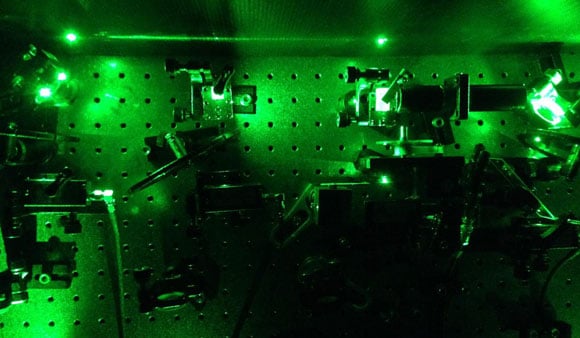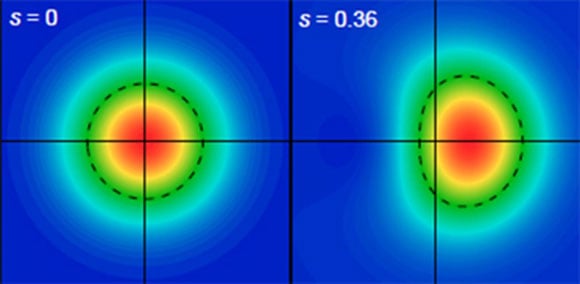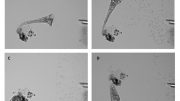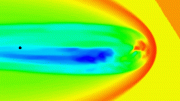
An image from an experiment in the quantum optics laboratory in Cambridge. Laser light was used to excite individual tiny, artificially constructed atoms known as quantum dots, to create “squeezed” single photons Credit: Mete Atature
Using an artificially constructed atom, known as a semiconductor quantum dot, a team of physicists has successfully demonstrated the squeezing of individual light particles.
A team of scientists has successfully measured particles of light being “squeezed”, in an experiment that had been written off in physics textbooks as impossible to observe.
Squeezing is a strange phenomenon of quantum physics. It creates a very specific form of light which is “low-noise” and is potentially useful in technology designed to pick up faint signals, such as the detection of gravitational waves.
The standard approach to squeezing light involves firing an intense laser beam at a material, usually a non-linear crystal, which produces the desired effect.
For more than 30 years, however, a theory has existed about another possible technique. This involves exciting a single atom with just a tiny amount of light. The theory states that the light scattered by this atom should, similarly, be squeezed.
Unfortunately, although the mathematical basis for this method – known as squeezing of resonance fluorescence – was drawn up in 1981, the experiment to observe it was so difficult that one established quantum physics textbook despairingly concludes: “It seems hopeless to measure it”.
So it has been proven – until now. In the journal Nature, a team of physicists report that they have successfully demonstrated the squeezing of individual light particles, or photons, using an artificially constructed atom, known as a semiconductor quantum dot. Thanks to the enhanced optical properties of this system and the technique used to make the measurements, they were able to observe the light as it was scattered, and proved that it had indeed been squeezed.
Professor Mete Atature, from the Cavendish Laboratory, Department of Physics, and a Fellow of St John’s College at the University of Cambridge, led the research. He said: “It’s one of those cases of a fundamental question that theorists came up with, but which, after years of trying, people basically concluded it is impossible to see for real – if it’s there at all.”
“We managed to do it because we now have artificial atoms with optical properties that are superior to natural atoms. That meant we were able to reach the necessary conditions to observe this fundamental property of photons and prove that this odd phenomenon of squeezing really exists at the level of a single photon. It’s a very bizarre effect that goes completely against our senses and expectations about what photons should do.”

The left diagram represents electromagnetic activity associated with light at its lowest possible level, according to the laws of classical physics. On the right, part of the field has been reduced to lower than is technically possible, at the expense of making another part of the field less measurable. This effect is called “squeezing” because of the shape it produces. Credit: Mete Atature
Like a lot of quantum physics, the principles behind squeezing light involve some mind-boggling concepts.
It begins with the fact that wherever there are light particles, there are also associated electromagnetic fluctuations. This is a sort of static which scientists refer to as “noise”. Typically, the more intense the light gets, the higher the noise. Dim the light, and the noise goes down.
But strangely, at a very fine quantum level, the picture changes. Even in a situation where there is no light, electromagnetic noise still exists. These are called vacuum fluctuations. While classical physics tells us that in the absence of a light source, we will be in perfect darkness, quantum mechanics tells us that there is always some of this ambient fluctuation.
“If you look at a flat surface, it seems smooth and flat, but we know that if you really zoom in to a super-fine level, it probably isn’t perfectly smooth at all,” Atature said. “The same thing is happening with vacuum fluctuations. Once you get into the quantum world, you start to get this fine print. It looks like there are zero photons present, but actually, there is just a tiny bit more than nothing.”
Importantly, these vacuum fluctuations are always present and provide a base limit to the noise of a light field. Even lasers, the most perfect light source known, carry this level of fluctuating noise.
This is when things get stranger still, however, because, in the right quantum conditions, that base limit of noise can be lowered even further. This lower-than-nothing, or lower-than-vacuum, state is what physicists call squeezing.
In the Cambridge experiment, the researchers achieved this by shining a faint laser beam onto their artificial atom, the quantum dot. This excited the quantum dot and led to the emission of a stream of individual photons. Although normally, the noise associated with this photonic activity is greater than a vacuum state, when the dot was only excited weakly the noise associated with the light field actually dropped, becoming less than the supposed baseline of vacuum fluctuations.
Explaining why this happens involves some highly complex quantum physics. At its core, however, is a rule known as Heisenberg’s uncertainty principle. This states that in any situation in which a particle has two linked properties, only one can be measured and the other must be uncertain.
In the normal world of classical physics, this rule does not apply. If an object is moving, we can measure both its position and momentum, for example, to understand where it is going and how long it is likely to take to get there. The pair of properties – position and momentum – are linked.
In the strange world of quantum physics, however, the situation changes. Heisenberg states that only one part of a pair can ever be measured, and the other must remain uncertain.
In the Cambridge experiment, the researchers used that rule to their advantage, creating a tradeoff between what could be measured, and what could not. By scattering faint laser light from the quantum dot, the noise of part of the electromagnetic field was reduced to an extremely precise and low level, below the standard baseline of vacuum fluctuations. This was done at the expense of making other parts of the electromagnetic field less measurable, meaning that it became possible to create a level of noise that was lower-than-nothing, in keeping with Heisenberg’s uncertainty principle, and hence the laws of quantum physics.
Plotting the uncertainty with which fluctuations in the electromagnetic field could be measured on a graph creates a shape where the uncertainty of one part has been reduced, while the other has been extended. This creates a squashed-looking, or “squeezed” shape, hence the term, “squeezing” light.
Atature added that the main point of the study was simply to attempt to see this property of single photons, because it had never been seen before. “It’s just the same as wanting to look at Pluto in more detail or establishing that pentaquarks are out there,” he said. “Neither of those things has an obvious application right now, but the point is knowing more than we did before. We do this because we are curious and want to discover new things. That’s the essence of what science is all about.”
Reference: “Quadrature squeezed photons from a two-level system” by Carsten H. H. Schulte, Jack Hansom, Alex E. Jones, Clemens Matthiesen, Claire Le Gall and Mete Atatüre, 31 August 2015, Nature.
DOI: 10.1038/nature14868









Esoptrics (from a Greek word for mirror), the logic of the mirror & key to an ALGEBRAIC (and thus purely logical as opposed to geometrical) model of the Universe = the only theory to identify (and in much detail and with mathematical precision to boot) the ultimate constituents from whose COLLECTIVE behavior arises what sense imagery gives us: a kind of time & a kind of space radically different from their ultimate constituents. It’s the same as how a bowling ball’s solidity emerges from the COLLECTIVE properties of atoms radically different individually from the individual bowling balls they compose. Compare with pg. 471 of the Feb. 2005 First Vintage Books paperback edition of Prof. Brian Greene’s “The Fabric Of The Cosmos” where he states “we’ve yet to identify” the “more fundamental constituents” from whose “collective behavior” arise the characteristics of “familiar space and time” (See also his pgs. 6, 335, 350-352, 486 & 493). It’s a claim he makes because he knows nothing of Esoptrics and its way of identifying those “more fundamental constituents” far more extensively than any other theory does.
On page 350, he writes of “the fabric of space” as perhaps being, on the Planck scale (i.e.: 10^-33 cm.) akin — METAPHORICALLY of course — to a “lattice or grid” between the lines of which space would be “outside the bounds of physical reality.” Only Esoptrics’ algebraic model of the Universe explains exactly why (though at 7.35×10^-47 cm.) Prof. Greene’s metaphor ideally illustrates figuratively what “the fabric of space” is ultimately in a Universe in which, ultimately, everything’s description is in Algebra’s purely logical & abstract terms rather than in Geometry’s 3 dimensional pictures.
Until the issue of the “ultramicroscopic makeup of space, time and matter” (Greene pg. 493) is settled, it’s never possible to be even so little as REASONABLY sure what’s coming from this-or-that theoretical physicist regarding what’s ULTIMATELY REAL is not merely a repeat of the old story of the 3 blind men each experiencing too little of the elephant to get an accurate grasp of what’s confronting him. In explaining how familiar time and space arise from the COLLECTIVE EFFECT of c. 10^464 unique sets of REAL RELATIONS (each by its makeup giving itself a unique logical location in a septuplex framework of logical sequences) Esoptrics comes far closer to that goal than any other theory does.
EDWARD N. HAAS (79) – HAASWOOD, LA
That is a wonderful article I really enjoyed, and it makes a lot of sense.
It is interesting that reducing the noise of parts of the electromagnetic field below the standard baseline of vacuum fluctuations at the expense of increasing it at other parts is very reminiscent of “squeezing” a balloon.
The presence of vacuum fluctuations made me think that maybe this universe at its entirety is an electromagnetic field, and that all things in it are different manifestations making different things, including light itself.
Also, given the “Heisenberg’s Uncertainty Principle,” maybe matter is made of a constant live stream at the quantum level serving the overall intended macrolevel object. In other words, while objects are the same overall at the macrolevel, they are constantly made up of new particles at the quantum level where the old ones decay, ad that’s why you can only catch either their position or momentum.